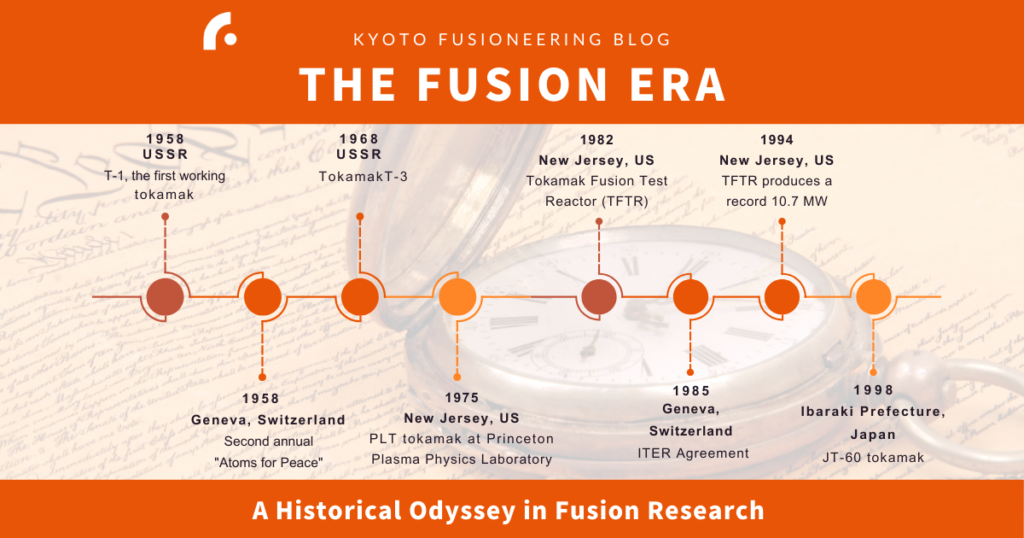
Welcome to “The Fusion Era” blog! In this blog series, we’re taking a trip through the past, present of fusion energy. As we step into 2024, we reflect on the historical journey that has paved the way for present breakthroughs and will guide future innovations in fusion. Fusion energy, the cosmic force driving the sun and stars, has fascinated scientists for decades. Replicating this phenomenon on Earth poses challenges, but our retrospective look is a testimony to the wealth of knowledge we’re leveraging in 2024. Join us as we explore the ongoing quest for clean, abundant energy and the global collaboration shaping its narrative.
Early Discoveries (1920s-1950s):
1920s: Astrophysicists like Arthur Eddington lay the theoretical foundation, proposing that stars draw energy from fusing hydrogen into helium.
1930s: Hans Bethe unravels the specific fusion reactions powering the sun.
1940s-50s: Governments initiate classified research programs; the US, UK, and Soviet Union explore fusion harnessing.
1950s: The pursuit of practical devices begins:
– Soviets propose the tokamak, a magnetic confinement device.
– Lyman Spitzer introduces the stellarator, another confinement concept.
Era of Experimentation (1960s-1980s):
– Late 1950s: Governments declassify fusion research, initiating global collaboration led by the International Atomic Energy Agency (IAEA) since 1958. Collaboration sparks with a 1978 treaty on U.S.-Japan fusion research.
1970s: The United States experiences a golden age of fusion, receiving broad governmental support and planning for future power plants.
1960s: The race is on! Exploration of various approaches includes magnetic confinement (tokamaks, stellarators), inertial confinement (lasers, particle beams), and hybrid concepts.
1968: A breakthrough occurs in the Soviet Union with the tokamak, achieving unprecedented temperature levels and plasma confinement times—two key criteria for fusion. The tokamak achieved unprecedented temperature levels and plasma confinement times, marking a significant step in fusion research.
Steady progress ensues globally; the Tore Supra tokamak in France sets a record for the longest plasma duration. The Japanese JT-60 achieves the highest value of fusion triple product.
In 1979 , the Joint European Torus (JET) project, involving 11 nations, comprising Belgium, Italy, Luxembourg, France, Netherlands, West Germany, Denmark, Ireland, Sweden, Switzerland, and the United Kingdom laid its foundations. The 1980s face growing funding constraints, leading to consolidation and a focus on scientific understanding. International collaboration strengthens with IAEA initiatives and the formation of the ITER project.
Modern Advances and the Road Ahead (1990s-Present):
1990s-2000s: Continued progress in plasma science and engineering paves the way for more efficient and powerful machines.
After two decades of negotiations, ITER is established in 2007 in France, aiming to demonstrate the scientific and technological feasibility of fusion energy production.
– ITER construction begins in France, with the goal of demonstrating net energy gain from fusion.
– Private companies enter the field, driving innovation and accelerating progress.
2010s-2020s: Focus shifts towards commercial viability and practical energy production.
– Advancements in materials science and superconducting magnets push performance boundaries. Advances in materials science and superconducting magnets are key components of improving fusion device performance.
– Demos and pilot plants emerge, proving the feasibility of small-scale fusion reactors.
These achievements bring fusion science to an exciting threshold: the long sought-after plasma energy breakeven point (Q=1). JET achieves a record fusion power output in 2021, producing 59 megajoules with a Q ratio of 0.33, surpassing its previous record in 1997.
In late 2022, researchers at the National Ignition Facility achieve breakeven, reaching a Q value of 1.5 using 2.05 megajoules of laser energy to produce 3.15 megajoules of fusion energy. However, the engineering associated with this laser confinement fusion approach is generally considered to be somewhat further away from practical application as a commercial energy source.
According to IAEA’s Fusion Device Information System (FusDIS), as of 2023, almost 130 experimental fusion devices and testing facilities are operating, under construction, or being planned, with a dozen demonstration plant or pilot plant designs under development.
As of now, nuclear fusion does not supply energy to the power grid. The focus remains on refining the technology and increasing investments. Worldwide, there are over 10 stellarators and 50 tokamaks in operation, yet none produce electricity. The fusion odyssey continues, poised on the brink of unlocking the potential of clean, abundant energy for our planet.
Resources:
- EuroFusion. (n.d.). JET History. EUROfusion. Retrieved from https://euro-fusion.org/devices/jet/jet-history/
- U.S. Fusion Energy. (n.d.). History of Fusion. Retrieved from https://usfusionenergy.org/history-fusion
- International Atomic Energy Agency. “From the IAEA Archives: A Retrospective of Nuclear Fusion Research.” IAEA, n.d. Retrieved from https://www.iaea.org/newscenter/multimedia/photogallery/from-the-iaea-archives-a-retrospective-of-nuclear-fusion-research
- International Atomic Energy Agency. (2023). IAEA World Fusion Outlook 2023. Retrieved from https://www.iaea.org/publications/15524/iaea-world-fusion-outlook-2023




